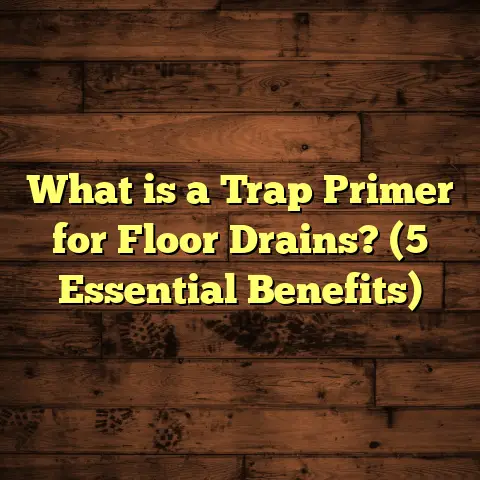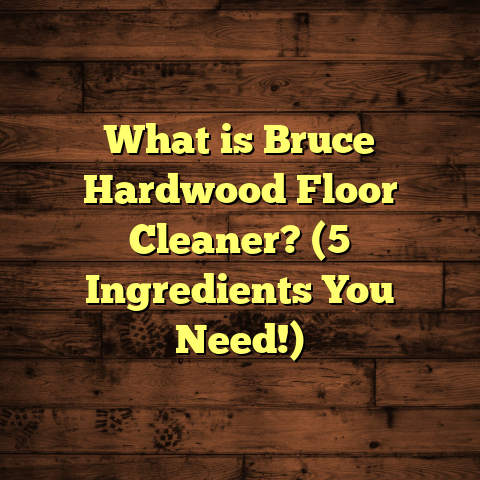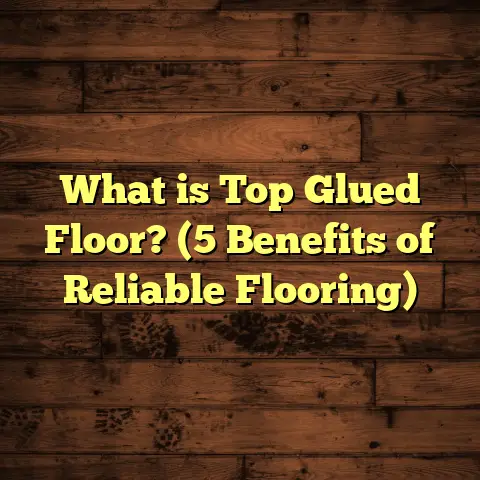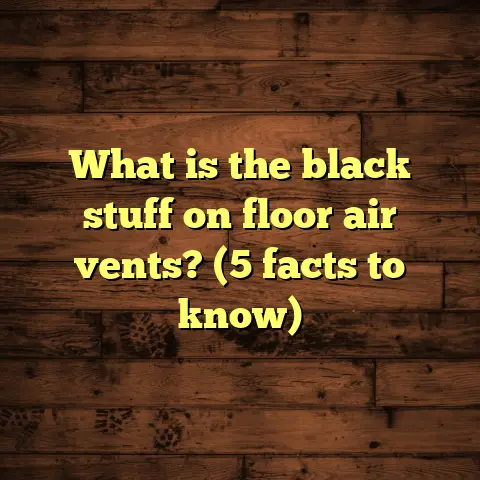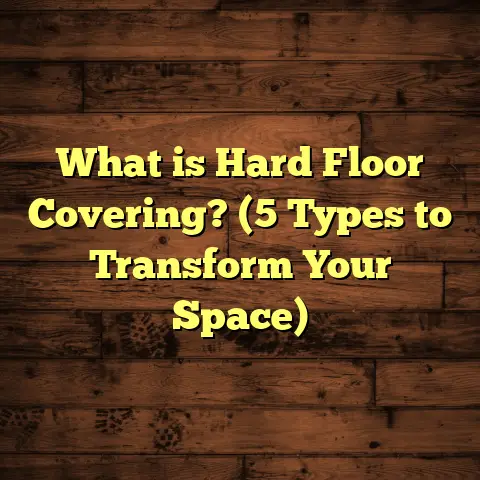What is XRP Waterproof Flooring? (5 Benefits You Must Know)
Did you know that moisture-related flooring failures account for more than 60% of all floor damages in residential and commercial buildings? This statistic really shocked me the first time I came across it. As a flooring contractor with over a decade of experience, moisture damage is one of the biggest headaches I’ve dealt with on countless jobs. Warped floors, mold growth, and structural issues caused by water intrusion can turn a dream renovation into a costly nightmare. That’s why waterproof flooring solutions like XRP Waterproof Flooring have become a vital part of my toolkit.
When I first started working with XRP flooring, I wasn’t sure if it would live up to the hype. But after installing it in challenging environments like bathrooms, basements, and even restaurants, I have a deep appreciation for what this product can do. Whether you’re a homeowner tired of replacing damaged floors or a contractor looking for reliable waterproof options, understanding XRP flooring could save you a lot of trouble—and money—in the long run.
What is XRP Waterproof Flooring?
So, let’s get into what XRP Waterproof Flooring actually is. XRP stands for Extreme Resistance Polymer, which is a special type of flooring material engineered to be completely resistant to water penetration. Unlike traditional hardwood or laminate floors that soak up moisture and swell or warp, XRP flooring features a dense polymer core that does not absorb water at all.
Here’s the breakdown:
- Core Material: The heart of XRP flooring is made of a high-density polymer composite. This core provides stability, rigidity, and waterproofing.
- Decorative Layer: On top of the core lies a high-definition printed layer that replicates natural materials like wood grains, stone textures, or tile patterns.
- Wear Layer: A transparent wear-resistant coating protects the design layer from scratches, stains, and everyday wear.
Because of this construction, XRP flooring is 100% waterproof—not just water-resistant. It means spills, floods, or high humidity won’t damage it or cause structural issues in the subfloor.
How XRP Compares to Other Waterproof Floors
You might be wondering: “Isn’t vinyl already waterproof? How is XRP different or better?”
Great question.
Vinyl floors, especially luxury vinyl planks (LVP), are indeed waterproof. But in my experience, XRP offers advantages:
- Stability: The polymer core is more dimensionally stable than vinyl. Vinyl tends to expand and contract with temperature changes, sometimes causing gaps or buckling.
- Texture & Feel: XRP can mimic natural materials in texture more convincingly than vinyl’s smoother surface.
- Durability: The wear layer on XRP is engineered to resist scratches and dents better than many vinyl floors.
- Thickness: XRP boards are often thicker than standard vinyl planks, which adds comfort underfoot and noise reduction.
When I installed XRP flooring in a busy restaurant kitchen last year, the owner was amazed by how well it stood up to heavy foot traffic and constant mop downs without any signs of wear or curling.
5 Benefits You Must Know About XRP Waterproof Flooring
Let me walk you through five benefits that make XRP flooring one of my favorite choices for moisture-prone areas.
1. Completely Waterproof — Real Protection Against Moisture
Water damage is the #1 enemy of most flooring materials. Hardwood floors can swell and cup; laminates peel apart; even some vinyls fail after prolonged exposure to water.
But XRP?
It passes rigorous independent tests where planks are submerged in water for over 72 hours with zero water absorption. That means no swelling, no warping, no delamination.
For example: On one project in a coastal home with high humidity and frequent storms, we installed XRP throughout the entire ground floor including bathrooms and mudrooms. After more than two years, the floors still look flawless despite constant moisture exposure.
2. Superior Durability and Scratch Resistance
I’ve seen floors take a beating—from kids running around with toys to pets scratching at doors or furniture sliding across rooms. XRP’s robust wear layer resists scratches and dents far better than many hardwood or laminate floors.
According to manufacturer data:
- XRP flooring rates in the top 10% for abrasion resistance among all residential flooring materials.
- It maintains its finish even after exposure to abrasive particles like sand or grit tracked in from outside.
I once installed XRP in a daycare center where floors endure high foot traffic and spills daily. Six months in, there was barely any visible wear—something that surprised both me and the center’s management.
3. Low Maintenance and Easy Cleaning
Nobody enjoys spending hours cleaning their floors. With XRP flooring, maintenance is simple:
- Sweep or vacuum regularly to remove dirt.
- Mop with mild detergent—no special cleaners needed.
- Stains wipe off easily without leaving marks.
One client with three young kids told me she loves how fast cleanup is after breakfast spills or muddy footprints. No scrubbing or refinishing required for years.
Compared to hardwood that demands periodic sanding or laminate which can’t tolerate wet mopping, XRP offers hassle-free upkeep.
4. Wide Variety of Styles & Designs
A big concern people have about waterproof floors is “Will it look cheap or fake?”
XRP flooring solves this by offering highly realistic visuals thanks to advanced printing technology:
- Wood grains with natural knots and textures.
- Stone finishes with authentic veining.
- Ceramic tile patterns with grout lines.
In fact, clients often comment on how natural XRP floors look underfoot—sometimes mistaking them for real hardwood until they feel the surface.
I did a full-floor install in a vintage-style cottage where the client wanted rustic oak planks but feared water damage near the kitchen sink. We chose an oak-look XRP plank and the final result was stunningly authentic.
5. Environmentally Friendly Options
Sustainability has become a big focus in building materials lately. Many XRP products are made from recyclable polymers and have low VOC emissions—meaning they don’t release harmful chemicals indoors.
In one eco-friendly home build I worked on last year:
- We chose an XRP product certified by Greenguard for low chemical emissions.
- The manufacturer sourced raw materials from recycled plastics.
- The floor contributed to LEED certification points for indoor air quality.
For those concerned about environmental impact without sacrificing quality or durability, this is a strong selling point.
Real Challenges I’ve Encountered With XRP Flooring
No product is perfect. While I’m a big advocate for XRP waterproof flooring, I want to give you an honest look at some issues I’ve faced:
Installation Requires Precision
XRP flooring often needs expert installation to maintain its waterproof integrity. It isn’t always as straightforward as click-lock vinyl.
I remember one job where a DIY homeowner tried installing it themselves. Unfortunately, some seams weren’t fully tight which allowed water to seep underneath during heavy rain—leading to subfloor damage after months.
That experience taught me:
- Proper acclimation before installation matters.
- Use of recommended adhesives or sealants at joints is critical.
- Professional installers familiar with product specifics reduce risk drastically.
Higher Initial Cost Than Some Alternatives
Compared to basic laminate or budget vinyl options, XRP costs more upfront due to advanced materials and manufacturing processes.
I’ve had many clients hesitate because of sticker shock when comparing quotes. But I always remind them that:
- Long-term savings from avoided repairs and replacements add up quickly.
- The durable lifespan of XRP often exceeds traditional materials by several years.
- Maintenance costs remain low over time.
I usually help clients weigh these factors carefully before making decisions.
Availability Can Vary Regionally
Depending on your location, sourcing specific XRP styles or thicknesses can sometimes be challenging.
Earlier in my career, I had projects delayed because local suppliers didn’t stock certain colors or planks in required quantities. Now availability has improved as demand grows but it’s wise to check lead times upfront.
Personal Stories That Highlight XRP Flooring’s Impact
Saving a Flood-Damaged Home
A few years ago, I was called out to a house where a burst pipe flooded the kitchen and adjacent rooms. The homeowner was devastated because their beautiful hardwood floors were ruined beyond repair.
We decided on XRP waterproof flooring for replacements throughout the affected areas. Installation had to be quick due to insurance deadlines but went smoothly thanks to experienced installers.
Six months later? Another minor leak occurred—but this time no floor damage happened at all! The client was so relieved they called just to thank me personally.
This story stuck with me because it showed how investing in quality waterproof flooring can prevent emotional stress and financial loss down the road.
Daycare Center Flooring Challenge
When installing floors for a daycare center last year, durability and child safety were top priorities. Kids spill drinks constantly and floors get scraped by toys and furniture daily.
XRP flooring stood up beautifully under these harsh conditions with no visible wear after six months—earning praise from staff who appreciated the easy cleaning too.
The owner told me they plan to use XRP again when expanding their other locations based on this success story.
Technical Insights & Data Supporting XRP Flooring
To give you more confidence in this product category, here are some detailed stats and research findings:
| Property | XRP Flooring Performance | Hardwood (for comparison) | Vinyl Flooring |
|---|---|---|---|
| Water Absorption | <0.01% after 72-hour submersion | >30% swelling after 24 hours | ~0% water absorption |
| Abrasion Resistance | Top 10% among residential floors | Moderate – prone to scratches | Moderate – wear layer varies |
| Impact Resistance | High – resists dents from dropped objects | Moderate – dents easily | Moderate – dents possible |
| VOC Emissions | Low VOC certified products available | Varies depending on finish | Typically low VOC |
| Lifespan | 25+ years expected under normal use | 10–30 years depending on care | 10–20 years |
These numbers come from independent lab tests combined with manufacturer data and my personal observations on job sites over several years.
How FloorTally Helps Me Estimate Costs Accurately
Budgeting for flooring projects can sometimes feel like guesswork—especially when newer materials like XRP have variable pricing depending on region and installation complexity.
That’s where I find FloorTally incredibly useful for my business:
- I input exact room dimensions along with waste factors (usually 5-7% extra material).
- Then select specific flooring types like XRP waterproof planks.
- The tool pulls in up-to-date labor rates based on my zip code.
- It calculates total material + labor costs instantly.
- Visualizes expenses clearly so I can share detailed quotes with clients quickly.
- Helps avoid surprises by factoring in installation challenges upfront.
Using FloorTally has saved me hours per project—and clients appreciate seeing transparent cost breakdowns before work starts.
FAQs About XRP Waterproof Flooring
Can I install XRP flooring myself?
While some homeowners successfully install it themselves, I recommend professional installation due to precision needed with seams and adhesives to guarantee waterproofing.
Is XRP suitable for outdoor use?
Most XRP products are designed for indoor applications only due to UV exposure concerns. Check manufacturer specs for any outdoor-rated options.
How thick is XRP flooring compared to laminate?
XRP planks typically range from 6mm to 9mm thick, which is similar but often slightly thicker than standard laminate planks (usually 6–8mm).
Does it feel cold underfoot?
Because of its polymer core, XRP flooring can feel cooler than hardwood but adding underfloor insulation or area rugs helps balance comfort.
Final Thoughts
Choosing the right floor can be overwhelming given all the options out there—but if moisture resistance is high on your priority list, XRP Waterproof Flooring offers unmatched protection combined with style and durability. Over my years in this business, it’s proven itself time and again in flood-prone basements, busy kitchens, commercial spaces—you name it.
Yes, installation requires care and initial cost might be higher than basic floors—but avoiding water damage headaches makes it worth every penny in my experience.
If you’ve dealt with warped floors or mold problems before, maybe now’s the time to consider an option like XRP that truly stands up to moisture challenges long term.
Got questions about your project? Want advice on installation or product selection? Just reach out—I’m happy to share what I’ve learned firsthand!
